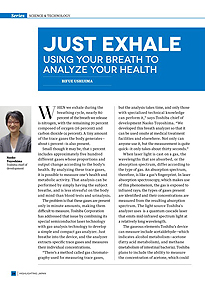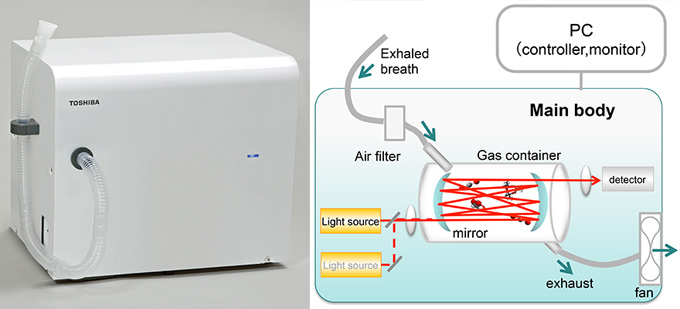Home > Highlighting JAPAN >Highlighting Japan August 2014>Science & Technology
Highlighting JAPAN

Science & Technology
Just Exhale
Using Your Breath to Analyze Your Health

When we exhale during the breathing cycle, nearly 80 percent of the breath we release is nitrogen, with the remaining 20 percent composed of oxygen (16 percent) and carbon dioxide (4 percent). A tiny amount of the trace gases the body generates—about 1 percent—is also present. Small though it may be, that 1 percent includes approximately five hundred different gases whose proportions and output change according to the body's health. By analyzing these trace gases, it is possible to measure one's health and metabolic activity. That analysis can be performed by simply having the subject breathe, and is less stressful on the body and mind than blood tests and urinalysis.
The problem is that these gases are present only in minute amounts, making them difficult to measure. Toshiba Corporation has addressed that issue by combining its special semiconductor laser technology with gas-analysis technology to develop a simple and compact gas analyzer. Just breathe into the device, and the analyzer extracts specific trace gases and measures their individual concentrations.
"There's a method called gas chromato-graphy used for measuring trace gases, but the analysis takes time, and only those with specialized technical knowledge can perform it," says Toshiba chief of development Naoko Toyoshima. "We developed this breath analyzer so that it can be used onsite at medical treatment facilities and elsewhere. Not only can anyone use it, but the measurement is quite quick—it only takes about thirty seconds."
When laser light is cast on a gas, the wavelengths that are absorbed, or the absorption spectrum, differ according to the type of gas. An absorption spectrum, therefore, is like a gas's fingerprint. In laser absorption spectroscopy, which makes use of this phenomenon, the gas is exposed to infrared rays; the types of gases present are identified and their concentrations are measured from the resulting absorption spectrum. The light source Toshiba's analyzer uses is a quantum cascade laser that emits mid-infrared spectrum light at a relatively long wavelength.
The gaseous elements Toshiba's device can measure include acetaldehyde—which indicates alcohol metabolism—acetone (fatty acid metabolism), and methane (metabolism of intestinal bacteria). Toshiba plans to include the ability to measure the concentration of acetone, which could indicate presence of obesity and diabetes, in 2015.
The company has also begun research and experimental trials in collaboration with Waseda University's Faculty of Sport Sciences to examine the connection between the concentration of acetone in an exhalation and the amount of fat a subject has burned. Acetone is generated when fat is burned for energy, and the acetone concentration rises. This occurs not only when exercising, but also when fasting and starving or after eating food high in fat. By studying acetone concentrations, Toshiba hopes to quantitatively measure the effect of diet and exercise on fat burning. Since the subject only needs to exhale, this method also has the advantage of allowing multiple readings per day.
In the future, the company is looking to measure more kinds of gases, and to expand the analyzer's applications.
"It's still difficult to diagnose illness through exhaled breath alone, but when combined with other biological information such as blood tests and urinalysis, we believe that it can be a useful tool in total body healthcare," says Toyoshima. Analyzing exhaled breath has a wide range of potential applications in the health field—such as providing guidance on exercise and diet, diagnosing illness, and gauging the effectiveness of medicine—and is garnering attention for its potential as a new biomarker.
© 2009 Cabinet Office, Government of Japan






